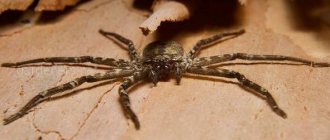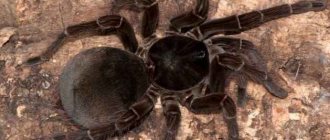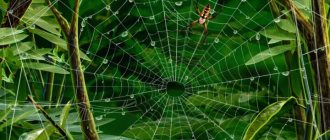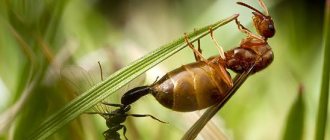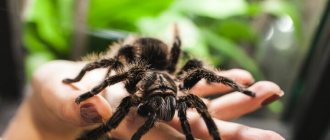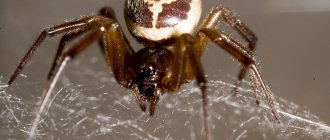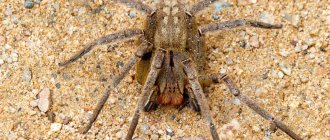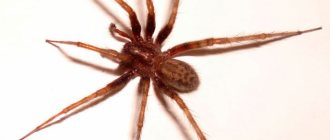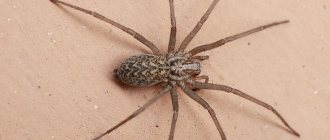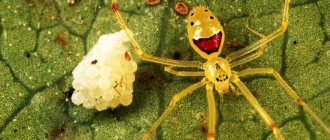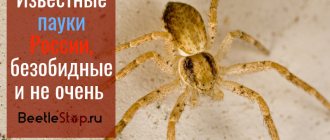What do you think people are most afraid of - guns or spiders? According to statistics, people feel more fear when they see creatures with many legs and eyes. This is very easy to believe, because seeing some of these creatures makes you want to burn everything they touched. Scary-looking spiders live not only in warm countries, but also here in Russia. For example, scientists recently discovered a completely new species of the so-called wolf spider, the mere sight of which can fill you with horror. Are you already wondering what they look like and how they can be dangerous?
Let's calm down first. In fact, if a wolf spider runs next to you in nature, you may not notice it - the largest species grow to a maximum of three centimeters. They most often live in grassy areas and damp forests, hiding in piles of fallen leaves and in burrows, shrouded inside with a thick layer of cobwebs. While walking through the forest, you will definitely not touch the web they have woven with your face, because they never catch prey using nets.
Why are spiders scary?
First of all, people are afraid of the appearance of spiders. Their body consists of two parts. The first is called the cephalothorax and includes eight eyes, and a pair of movable limbs, with the help of which males attract females and push food into their mouths. The second part is the abdominal cavity, which contains all the other internal organs of the animal.
The location of the spider's eyes: four small ones at the bottom, two large ones at the top and another pair on the sides
The body of spiders is colored black, gray or brown, and light-colored individuals are very rare. Dark coloring helps spiders hide from predators by camouflaging themselves under foliage and tree bark. Their appearance also helps them to be invisible to prey, which they can see at a distance of up to 30 centimeters and attack in a jump.
The web is needed for insurance
Jumping spiders use web threads to attack. They attach a safety thread to an object and jump onto the intended victim. The South Russian tarantula, leaving its hole, pulls behind it a barely noticeable cobweb thread, along which it will always find the entrance to the abandoned shelter. If the insurance breaks, the tarantula is unable to find its hole and goes in search of a new one. Jumping spiders spend the night on web threads attached to the substrate. This is a kind of insurance against predators.
The main task of the web is to catch prey.
What do spiders eat?
As a rule, wolf spiders hunt small bugs and are not averse to eating flies and insect larvae. They lead a solitary lifestyle and crawl out of their hiding places only at night - apparently, they are afraid of becoming victims of predators. However, sometimes spiders manage to eat even during the day, if some insect has the courage to run past their hole.
Spider on the hunt
When attacking a victim while jumping, these creatures protect themselves from falling by pre-attaching a web to the place from which the jump is made. Quite clever for spiders, isn't it? This is nothing - some of these creatures are even capable of learning, for example, jumping. Their skill is then used by scientists to create robots.
Why do spiders build trapping webs?
The ability to produce a patina is not a primary characteristic of spiders, but web-weaving has become a distinctive feature of arachnids. Spiders are true predators, waiting for their prey in a secluded place.
Thanks to the adhesive properties of the web, a wide variety of animals, ranging from insects and even small birds, get caught in spider webs.
Having stuck to the web, the victim tries to get out of the trap by swinging the web thread. The resulting vibrations are transmitted along the signal thread to the spider, which quickly approaches the prey along the threads and injects digestive juice, which, upon entering the victim, digests the internal contents. Then the spider flies off with its web, forming something like a cocoon. It remains to wait a little until the digestive enzymes make it possible to simply suck out the liquid contents.
The most terrible spiders
Each species of spider is scary in its own way, but this one can make you freeze in horror with its method of caring for its offspring. The fact is that the females of these creatures lay eggs and carry them on their backs for a long time, attaching them with a web. Not scary yet? Then see what the female looks like after hatching her babies.
Sometimes there are so many children that the spider’s body is completely covered with them - only the eyes remain visible. Dozens of tiny spiders ride on their mother's back until they learn to forage for food on their own. Imagine seeing such a spectacle at home - it was precisely for such occasions that Elon Musk probably started selling flamethrowers.
The Web: Fun Facts for the Curious
The bodies of most species of spiders contain approximately enough webs to create 3 entire webs. On average, a spider can pull out about 30 meters of silk thread.
Silk is stored as a special protein substrate that floats randomly. But as soon as this protein substrate is pulled through a specially shaped gland, it immediately changes.
Coming out of the spider's body through the arachnoid warts, the silk thread changes its state, becoming unusually hard.
Spider web under a microscope
Spider silk consists of two types of proteins: long and other proteins.
Long proteins give the thread extraordinary strength, while other proteins line up chaotically and make the thread extremely elastic.
If you calculate it by weight, then spider silk is stronger than steel and an order of magnitude stronger than Kevlar.
Spiders have several silk-secreting glands, which allows them to change the properties of the silk they produce. Depending on the need, the following characteristics of the thread change: strength, diameter and density.
When weaving a web, the spider first pulls on a kind of star, which serves as a support. The star is woven from high density silk. Next, he creates a temporary frame, and then stretches the sticky silk.
The glue with which spiders cover the threads of the web, due to its electrostatic properties, causes the threads of the web to be drawn towards the insects, which in the process of flight and friction with the air have accumulated a static charge. The threads can deflect up to 2 mm, but at a high speed of 2 m/s.
Under an electron microscope, it can be seen that the sticky thread consists of special “pearls” that form upon contact with moisture in the air. The pearls are very small drops of glue.
The tips of a spider's legs under an electron microscope
In order not to become a victim of its own trap and not to “get dirty” with glue, the spider covers the tips of its own legs with a special substance, which in its composition is very similar to wax.
By the way, if the wind is very strong and the spider may lose its own web, then the spider will urgently begin dismantling the woven structure. The spider eats its web, processing the silk.
During the course of a day, a spider can weave and dismantle its web twice.
Spitting spider
But not all spiders have a silk gland located in the back of the animal. There are 150 species of spitting spiders (Scytodidae), which have a silk gland located in the head. These spiders do not weave a web, but rather throw it over the victim, using silk as a net.
Some photos belong to Nat Geo Wild
How dangerous are spiders to humans?
Don't you think that a person can die even from the slightest touch of these terrible spiders? In fact, everything is not as scary as it seems. Firstly, wolf spiders do not attack people unless provoked. Secondly, this type of spider is not poisonous and a bite can hardly lead to the death of a person.
The maximum that a person feels after a spider bite is a slight pain and itching. Despite this, it is best to be wary of tropical wolf spiders because they bite much more painfully and the effects include swelling, dizziness and nausea. If such trouble happens to someone, it is important to consult a doctor.
How to get rid of it?
If there are a lot of spiders and their presence is annoying the owners of the living space, it is necessary to get rid of them.
There are several ways to deal with uninvited guests:
- clean the apartment thoroughly . Collect all the cobwebs along with the owners sitting in them (we recommend doing this with a vacuum cleaner). Catch all the spiders you see and destroy them. If you don’t dare kill a living creature, throw them outside, away from the house. Cover all ventilation openings in the room with gauze or fine mesh to prevent furry arthropods from returning;
- we fight reproduction . Soak a rag in the bleach solution and wipe all the corners, floors, bottoms and backs of furniture (they prefer to lay their eggs in these places). You can use chemicals such as Dichlorvos or other modern drugs;
- food deprivation . Before destroying arachnids, get rid of all insects living in the house: cockroaches, flies, bedbugs, etc. As soon as food becomes scarce, spiders will leave your house in search of a more nourishing place;
- repair . If you were planning to renovate the premises, now is the time to do it. Any representatives of the spider tribe cannot tolerate the smell of paint and some building mixtures. A couple of days after the start of repairs, arthropods will run away from the house;
- aromatherapy . The most pleasant method of dealing with unpleasant neighbors. Arthropods do not like strong aromas: eucalyptus, citrus, mint, chestnut. You can use aromatic oils or air fresheners with these scents;
- duct tape . Sticky tapes that are used to get rid of flies are also suitable for arthropods. You need to stick them in corners and behind furniture.
When you have managed to get rid of small animals, you need to prevent their reappearance:
- Clean regularly, paying special attention to corners and spaces under sofas and cabinets;
- drive the first spider you see out of the house, because soon numerous offspring may arise from one guest.
New species of spiders
The scary spiders shown above are unlikely to be encountered in Russia. However, in Altai you can find their smaller counterparts, which were recently discovered on the territory of the Katunsky Nature Reserve. They live in mountainous areas along with other species of wolf spiders, which struck scientists as an extremely strange phenomenon. They had never seen different species of these spiders living in close proximity before.
This “handsome guy” can easily be found in Russia
According to scientists, the new species of spiders is very cowardly - when they see a person, they immediately hide under stones. Nevertheless, the researchers managed to photograph them and catch several individuals for study in the laboratory. At the moment, the species does not even have an official name, but after studying it will definitely appear.
Hate spiders? Wasps too, that's why they turn them into zombies
Spiders climb into houses in winter to wait out the cold
It is quite logical to strive for warmth during the cold season. However, most spiders found indoors are not strays that got there by accident. They are the descendants of entire generations of house spiders that have evolved over the years to adapt to a persistently temperate climate and poor food and water sources. Most often, these spiders leave their eggs in furniture and other home nooks and crannies.
Less than 5% of house spiders have ever been outside. Therefore, an operation to “rescue” such a spider and transfer it to the wild can end in failure.
How does a spider weave a web?
The spider has from 1 to 4 pairs of arachnoid glands at the back of the abdomen, from which a thin thread of web appears. This is a special secret, which today is called nothing other than liquid silk. Coming out of the thin spinning tubes, it begins to harden in the air, and the thread that ends up turns out to be so thin that it is not easy to see with the naked eye.
Read also: TOP 20 amazing facts about animals
To weave a web, the spider spreads its own spinning organs. After this, he waits for a light breeze so that the spun web can catch on a nearby support. After this has happened, the arachnid representative moves with its back down along the created bridge and weaves a radial thread.
When the base of the web has already been created, the spider moves in a circle and weaves transverse thin threads, which are very sticky, into its own “product.”
It is also important to note that spiders are considered to be quite economical creatures, and therefore damaged or old webs are absorbed by them and then reused.
Ways to fight
The presence of different types of house spiders causes psychological discomfort, negatively affects the aesthetics of the room (due to cobwebs and the remains of dead insects), and can pose a threat to health (if we are talking about poisonous species that accidentally entered the room).
Also, if you do not fight nearby arachnids, they will begin to multiply and spread throughout the room.
To combat spiders, it is best to use repellents; the use of pesticides is only a last resort. The following will help drive away arthropods:
- get rid of all kinds of insects (if there are bugs or insects in the house, they must be poisoned);
- network destruction;
- general wet cleaning (even in hard-to-reach places);
- seal all cracks and crevices;
- installation of mosquito nets on windows and ventilation openings.
You can use folk remedies:
- When cleaning, add vinegar to the water;
- put aroma lamps with oils (eucalyptus, mint, lemon, orange, tea tree);
- Scatter horse chestnut fruits in the corners.
If the measures taken do not help, you should treat the room with an insecticidal preparation. You should choose products specifically designed for spider control and follow the instructions and precautions when using them.
